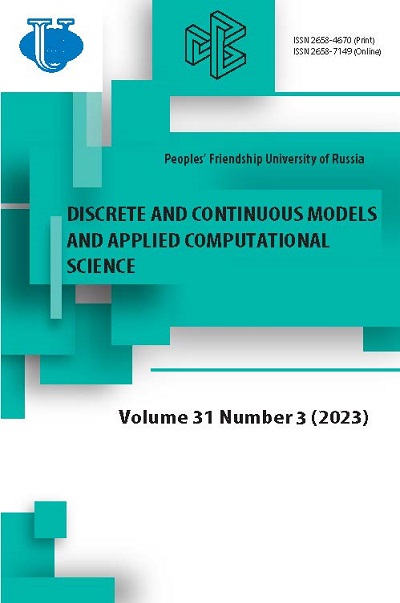Numerical integration of the Cauchy problem with non-singular special points
- Authors: Belov A.A.1,2, Gorbov I.V.1
-
Affiliations:
- M.V. Lomonosov Moscow State University
- Peoples’ Friendship University of Russia (RUDN University)
- Issue: Vol 31, No 3 (2023)
- Pages: 218-227
- Section: Articles
- URL: https://journals.rudn.ru/miph/article/view/35918
- DOI: https://doi.org/10.22363/2658-4670-2023-31-3-218-227
- EDN: https://elibrary.ru/YENIDI
Cite item
Full Text
Abstract
Solutions of many applied Cauchy problems for ordinary differential equations have one or more multiple zeros on the integration segment. Examples are the equations of special functions of mathematical physics. The presence of multiples of zeros significantly complicates the numerical calculation, since such problems are ill-conditioned. Round-off errors may corrupt all decimal digits of the solution. Therefore, multiple zeros should be treated as special points of the differential equations. In the present paper, a local solution transformation is proposed, which converts the multiple zero into a simple one. The calculation of the latter is not difficult. This makes it possible to dramatically improve the accuracy and reliability of the calculation. Illustrative examples have been carried out, which confirm the advantages of the proposed method.
Full Text
1. Introduction Consider the Cauchy problem for an ordinary differential equation (ODE)About the authors
Aleksandr A. Belov
M.V. Lomonosov Moscow State University; Peoples’ Friendship University of Russia (RUDN University)
Email: aa.belov@physics.msu.ru
ORCID iD: 0000-0002-0918-9263
Candidate of Physical and Mathematical Sciences, Assistant professor of Department of Computational Mathematics and Artificial Intelligence of Peoples’ Friendship University of Russia (RUDN University); Researcher of Faculty of Physics, M.V. Lomonosov Moscow State University
1, bld. 2, Leninskie Gory, Moscow, 119991, Russian Federation; 6, Miklukho-Maklaya St., Moscow, 117198, Russian FederationIgor V. Gorbov
M.V. Lomonosov Moscow State University
Author for correspondence.
Email: garri-g@bk.ru
ORCID iD: 0009-0005-5335-6179
Master’s degree student of Faculty of Physics
1, bld. 2, Leninskie Gory, Moscow, 119991, Russian FederationReferences
- E. Janke, F. Emde, and F. Losch, Tafeln Horer Functionen. Stutgart: B.G. Teubner Verlagsgesellschaft, 1960.
- NIST Digital Library of Mathematical Functions, https://dlmf.nist.gov.
- M. K. Kerimov, “Studies on the zeros of Bessel functions and methods for their computation,” Computational Mathematics and Mathematical Physics, vol. 54, pp. 1337-1388, 2014. doi: 10.1134/S0965542514090073.
- N. N. Kalitkin and P. V. Koryakin, Numerical methods. Vol.2: Methods of mathematical physics [Chislennye Metody. T.2: Metody matematicheskoi fiziki]. Moscow: Akademiya, 2013, in Russian.
- A. A. Belov, “Numerical detection and study of singularities in solutions of differential equations,” Doklady Mathematics, vol. 93, no. 3, pp. 334-338, 2016. doi: 10.1134/S1064562416020010.
- A. A. Belov, “Numerical blow-up diagnostics for differential equation solutions,” Computational Mathematics and Mathematical Physics, vol. 57, no. 1, pp. 122-132, 2017. doi: 10.1134/S0965542517010031.
- A. A. Belov and N. N. Kalitkin, “Numerical integration of a Cauchy problem whose solution has integer-order poles on the real axis,” Differential equations, vol. 58, pp. 810-833, 2022. doi: 10.1134/S0012266122060088.
- V. I. Shalashilin and E. B. Kuznetsov, The method of continuation by parameter and the best parametrization [Metod prodolzheniia po parametru i nailuchshaia parametrizatsiia]. Moscow: Editorial URSS, 1999, in Russian.
- E. B. Kuznetsov and S. S. Leonov, “Parametrization of the Cauchy problem for systems of ordinary differential equations with limiting singular points,” Computational Mathematics and Mathematical Physics, vol. 57, pp. 931-952, 2017. doi: 10.1134/S0965542517060094.
- E. A. Alshina, E. M. Zaks, and N. N. Kalitkin, “Optimal parameters of explicit Runge-Kutta schemes of low orders [Optimalnye parametry iavnykh skhem Runge-Kutty nizkikh poriadkov],” Math. modeling, vol. 18, no. 2, pp. 61-71, 2006, in Russian.
- H. H. Rosenbrock, “Some general implicit processes for the numerical solution of differential equations,” The Computer Journal, vol. 5, no. 4, pp. 329-330, 1963. doi: 10.1093/comjnl/5.4.329.
- N. N. Kalitkin and I. P. Poshivaylo, “Inverse Ls-stable Runge-Kutta schemes,” Doklady Mathematics, vol. 85, pp. 139-143, 2012. DOI: 10. 1134/S1064562412010103.
- N. N. Kalitkin and I. P. Poshivaylo, “Computations with inverse Runge-Kutta schemes,” Mathematical Models and Computer Simulations, vol. 6, pp. 272-285, 2014. doi: 10.1134/S2070048214030077.
- E. Hairer and G. Wanner, Solving ordinary differential equations. II. Stiff and differential-algebraic problems. Berlin, New York: Springer-Verlag, 1996.
- L. F. Shampine and M. W. Reichelt, “The Matlab ODE suite,” SIAM Journal on Scientific Computing, vol. 18, no. 1, pp. 1-22, 1997. doi: 10.1137/S1064827594276424.
















